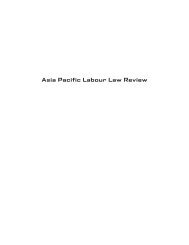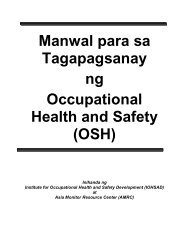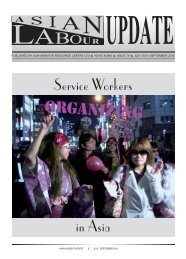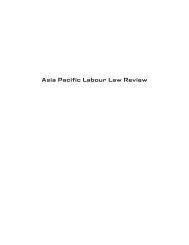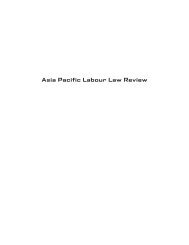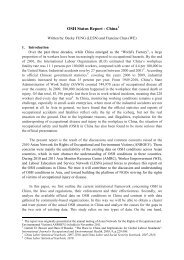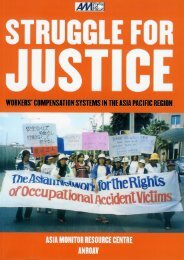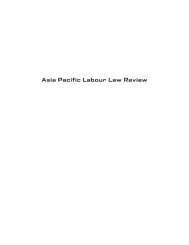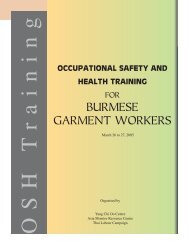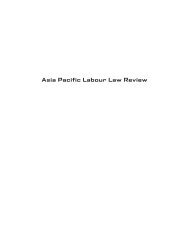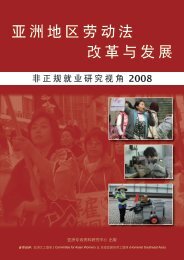Survey Report of OSH Textile and Garment Sectore in Indonesia.pdf
Survey Report of OSH Textile and Garment Sectore in Indonesia.pdf
Survey Report of OSH Textile and Garment Sectore in Indonesia.pdf
You also want an ePaper? Increase the reach of your titles
YUMPU automatically turns print PDFs into web optimized ePapers that Google loves.
REPORT<strong>Survey</strong> <strong>of</strong> Occupational Health <strong>and</strong> SafetyOn <strong>Garment</strong> <strong>and</strong> <strong>Textile</strong>In <strong>Indonesia</strong>By:Local Initiative for <strong>OSH</strong> Network(LION) <strong>Indonesia</strong>Supported by:Asian Monitor<strong>in</strong>g Resource Centre(AMRC) Hong Kong
B<strong>and</strong>ung2010LIST <strong>of</strong> CONTENTI. INTRODUCTION1. Background2. Occupation Safety <strong>and</strong> Health problematic3. Purpose <strong>of</strong> <strong>Survey</strong>4. <strong>Survey</strong> Context5. Method <strong>and</strong> <strong>Survey</strong> PartnerII. SURVEY FINDING1. About <strong>Textile</strong> <strong>and</strong> <strong>Garment</strong> Industry <strong>in</strong> <strong>Survey</strong>2. Respondent Pr<strong>of</strong>ile
a. Respondent Base on Educationb. Respondent Base on Wagec. Respondent Base on Work<strong>in</strong>g Timed. Respondent base on Work Protectione. Respondent base on K<strong>in</strong>d <strong>of</strong> Medical Facility3. Respondent Base on Occupational Safety <strong>and</strong> Health <strong>in</strong> Work Placea. Work Environmentb. Personal Protection Equipment <strong>in</strong> Companyc. Problem Healthy Base on Time <strong>of</strong> Work<strong>in</strong>gd. Health Problem Base on Labor Position4. Woman Labor Participant <strong>and</strong> reproductive Healtha. Woman Labor participantb. Health Facilityc. Sexual Harassmentd. Reproductive HealthIII. AN ANALYSIS OF <strong>OSH</strong> CONDITION ON THE GARMENT AND TEXTILE INDUSTRYa. Wage <strong>and</strong> Age <strong>of</strong> Workb. Work Environment <strong>and</strong> Hazard Potentialc. Woman Labor Participant <strong>and</strong> Reproductive HealthIV. SUMMARY AND RECOMMENDATION1. Summary2. Recommendation <strong>and</strong> next Activity/program
are strengthened by Labor Act No. 13/2003 <strong>in</strong> article 86 <strong>and</strong> 87. Article 86 states thatevery worker are entitled to have protection on occupational safety <strong>and</strong> health, protectionon physical <strong>and</strong> non physical, <strong>and</strong> to be treated with dignity <strong>and</strong> the religion value.Chapter 87 states that every <strong>in</strong>dustry has to implement <strong>OSH</strong> management system to be<strong>in</strong>tegrated <strong>in</strong>to general management system. Occupational safety <strong>and</strong> health is <strong>in</strong>cludedalso <strong>in</strong> sectoral national regulation such as Medicare legislation, <strong>and</strong> other regulations thatrelated with m<strong>in</strong><strong>in</strong>g, nuclear, oil <strong>and</strong> geo gas, <strong>in</strong>dustrialist etc.Jamsostek nature is assurance which ones will be served if become member <strong>and</strong> paid thedues. As a concept <strong>and</strong> practically, the system <strong>of</strong> Jamsostek is not a system for protection.Jamsostek is not giv<strong>in</strong>g benefit optimally to the member (workers <strong>and</strong> their family).Besides that, Jamsostek is only for formal workers. It is based on the law <strong>of</strong> Jamsostekitself which takes form as <strong>in</strong>corporated company by the pr<strong>in</strong>ciple <strong>of</strong> “Pr<strong>of</strong>it Oriented”.Through this provision, Jamsostek are subjected under the m<strong>in</strong>istry <strong>of</strong> State OwnedEnterprises State (BUMN) (Act No. 19 years <strong>in</strong> 2003) obliged to provide dividends for thegovernment. In addition, the Social Security Act has no power <strong>of</strong> execution, because thesanctions given to company that has not registered the workers to the Social Securityprogram is weak. In 2007, <strong>of</strong>ficial data showed that only 8.1 million workers registered asJamsostek member. However, more than 23 million workers <strong>and</strong> tens <strong>of</strong> millions <strong>of</strong><strong>in</strong>formal workers are not a member <strong>of</strong> the Jamsostek (DPP FSPMI, November 25, 2009).Thus, the fulfillment <strong>of</strong> <strong>OSH</strong> cannot be measured only by the membership <strong>in</strong> Jamsostek.Another measures to assess the fulfillment <strong>of</strong> <strong>OSH</strong> are the extent <strong>of</strong> employment to bechoosen, the extent <strong>of</strong> wage to meet labor needs <strong>and</strong> the extent <strong>of</strong> production processescan prevent accidents <strong>and</strong> illness <strong>of</strong> occupational related, <strong>in</strong>clud<strong>in</strong>g work<strong>in</strong>g hours, age,sex, work environment <strong>and</strong> whole <strong>in</strong>formation about the level <strong>of</strong> danger <strong>in</strong> the workplace.Low wages for example, will have an impact on the poor quality <strong>of</strong> workers life. It wouldencourage workers to take excessive work<strong>in</strong>g hours. And, it will decrease the healthconditions <strong>of</strong> workers'.Thereby supported or not <strong>OSH</strong> couldn’t be measured with register<strong>in</strong>g <strong>of</strong> Jamsostek only,but it measured by how far <strong>of</strong> choos<strong>in</strong>g work opportunity is available, labor wagesupport<strong>in</strong>g their needs, production process can prevent an accidents <strong>and</strong> disease, <strong>in</strong>clud<strong>in</strong>gwork<strong>in</strong>g time, age, gender, environment <strong>and</strong> <strong>in</strong>formation about risk/hazard level <strong>in</strong>work<strong>in</strong>g place.Low wages, for an example, can effect to low quality <strong>of</strong> worker life. That th<strong>in</strong>g can forcethe worker to take more over time work<strong>in</strong>g that effected to decreas<strong>in</strong>g <strong>of</strong> labor healthcondition. It will become worst if the situation <strong>of</strong> production processes uses <strong>in</strong>frastructurewhich harmful to the safety <strong>and</strong> job security.Table 1Occupational Accident Data 2007-2008Occupational Accident Data 2007 2008Number <strong>of</strong> Occupational Accident case 83.714 93.823
a. unable to work temporarilyb. Physical defectc. DeathSource: PT Jamsostek.--1.8836.565442.124The above data <strong>in</strong>dicates the <strong>in</strong>creas<strong>in</strong>g occupational accidents cases. The data which notdisclosed by Jamsostek is the numbers <strong>of</strong> illness related to work as prescribed by the lawNo. 22 Year 1993 concern<strong>in</strong>g illness due to Work. Methodically, Jamsostek organizes thedata based on company report <strong>of</strong> Jamsostek member. Though, not all companies registerthe workers to Jamsostek. Suppos<strong>in</strong>g registered, it is only for one course; Old Age Security<strong>in</strong>surance for example. The rest covered to the other <strong>in</strong>surance agencies or not at all.Accord<strong>in</strong>g to ILO, the real accidents data <strong>in</strong> <strong>Indonesia</strong> could reach five times more thanthe data recorded <strong>in</strong> the Office <strong>of</strong> Labor <strong>and</strong> Jamsostek. This is ma<strong>in</strong>ly related to the weaksupervision on manpower <strong>and</strong> a m<strong>in</strong>imum report<strong>in</strong>g <strong>of</strong> workplace accidents from thecompany.The problem <strong>in</strong> implement<strong>in</strong>g <strong>of</strong> <strong>OSH</strong> is not only related to the awareness <strong>of</strong> workers butalso, the extent <strong>of</strong> <strong>in</strong>formation about work safety <strong>and</strong> security is socialized to the worker,the extent <strong>of</strong> wages that received can reduce the load <strong>and</strong> work<strong>in</strong>g hours, the extent <strong>of</strong>protection equipment is provided by company, the extent <strong>of</strong> the work<strong>in</strong>g environment issafety for the worker, the extent <strong>of</strong> women to feel protected <strong>in</strong> work<strong>in</strong>g place, or theextent <strong>of</strong> union's underst<strong>and</strong><strong>in</strong>g about <strong>OSH</strong>.Purpose <strong>of</strong> <strong>Survey</strong>Aim <strong>of</strong> this survey is to get a clear picture <strong>of</strong> work condition <strong>in</strong> textile <strong>and</strong> garment <strong>in</strong>context <strong>of</strong> Labor Market Flexibility (LMF) <strong>in</strong>tensification. Technically, this surveycooperates with Unions on company <strong>and</strong> branch level. This survey is expected to be usefulfor unions as data base for <strong>OSH</strong> condition <strong>in</strong> company; after know<strong>in</strong>g <strong>OSH</strong> condition <strong>in</strong><strong>in</strong>dustry, unions can monitor the <strong>OSH</strong> implementation <strong>in</strong> factory. In the company level, theresult <strong>of</strong> survey is expected to be “ammunitions” for union to push collective barga<strong>in</strong><strong>in</strong>gagreement (Perjanjian Kerja Bersama/PKB) that ensure the fulfillment <strong>of</strong> <strong>OSH</strong>.For branch level unions, the survey results are expected to capture the urgency <strong>of</strong> <strong>OSH</strong>’sstruggle <strong>in</strong> the middle <strong>of</strong> flexible employment system. In this context, the <strong>OSH</strong> issue isexpected to be a medium <strong>of</strong> consolidation to unions <strong>and</strong> Non-Government Organization(NGO). The <strong>in</strong>formation will encourage union to plan <strong>OSH</strong> program with<strong>in</strong> union. Inforward, this research will be the basic material for educational assistance <strong>of</strong> <strong>OSH</strong> <strong>in</strong> union<strong>and</strong> the framework <strong>of</strong> advocacy at the level <strong>of</strong> policy holders.Essentially, the result <strong>of</strong> this survey is owned by the union. Therefore, all result will bespread to eight cities that chosen as research partners.
<strong>Survey</strong> ContextThis survey is not <strong>in</strong> a vacuum, but covered with macroeconomic Policy <strong>of</strong> <strong>Indonesia</strong>,where <strong>Indonesia</strong> as one <strong>of</strong> producer <strong>and</strong> supplier <strong>of</strong> natural resource for <strong>in</strong>ternationalmarket, human resource provider, <strong>and</strong> market for <strong>in</strong>ternational product.In addition, this survey is conducted <strong>in</strong> the situation context which union is obstructed,both functionally as well as collectively either by companies or by the state. This situationhas weakened the barga<strong>in</strong><strong>in</strong>g position <strong>of</strong> unions to fight for their collective <strong>in</strong>terests.Because, <strong>in</strong> practice, each worker was "forced" to survive alone; <strong>in</strong>dividual contracts,<strong>in</strong>dividual negotiation <strong>and</strong> settlement <strong>of</strong> cases <strong>in</strong>dividually. The union is not prohibiteddirectly. However, the ma<strong>in</strong> functions <strong>of</strong> union are slowly eroded. The weaken<strong>in</strong>g <strong>of</strong>unions is happen<strong>in</strong>g by decreas<strong>in</strong>g the number <strong>of</strong> union members due to the companyeasily do the sack<strong>in</strong>g (Term<strong>in</strong>ation <strong>of</strong> Employment), us<strong>in</strong>g the impermanent workers, <strong>and</strong>us<strong>in</strong>g other parties to do recruitment (outsourc<strong>in</strong>g). Integral with the legalization <strong>of</strong> laboroutsourc<strong>in</strong>g is the grow<strong>in</strong>g <strong>of</strong> home-based workers from the labor agency service providers.These phenomena are part <strong>of</strong> the practice <strong>of</strong> Labor Market Flexibility (LMF). Today, LMFpractically is runn<strong>in</strong>g <strong>and</strong> many countries try to fight <strong>in</strong>clud<strong>in</strong>g <strong>Indonesia</strong>.Method <strong>and</strong> <strong>Survey</strong> PartnerThis research was us<strong>in</strong>g the method <strong>of</strong> survey, focus group discussion (FGD) <strong>and</strong> <strong>in</strong>terview.FGD <strong>and</strong> <strong>in</strong>terview was conducted to complete the data <strong>and</strong> strengthen the surveyf<strong>in</strong>d<strong>in</strong>gs. Besides that, tra<strong>in</strong><strong>in</strong>g <strong>and</strong> workshop <strong>of</strong> <strong>OSH</strong> were also conducted. Both are usedto discuss about <strong>OSH</strong> policy.<strong>Survey</strong> tools used an active questioner. The term is used to describe that the surveyor wasassist<strong>in</strong>g, giv<strong>in</strong>g explanation <strong>and</strong> discuss<strong>in</strong>g with the respondent. The purpose <strong>of</strong> thismethod is to avoid assumption that respondent is an object for the research. <strong>Survey</strong>or <strong>and</strong>the respondent are <strong>in</strong>teractively try<strong>in</strong>g to underst<strong>and</strong> that <strong>OSH</strong> problem is problem to all.The essence <strong>of</strong> questioner is explor<strong>in</strong>g the <strong>in</strong>dustry pr<strong>of</strong>ile, labor status, the extent <strong>of</strong>normative labor rights which supported <strong>and</strong> how the fulfillment <strong>of</strong> those right. Thenormative rights <strong>in</strong> the questioner are concern about <strong>OSH</strong> case <strong>in</strong> the factory.FGD was undertaken with local partner <strong>and</strong> labor unions. FGD was discuss<strong>in</strong>g the extent <strong>of</strong>union attention on the issue <strong>of</strong> <strong>OSH</strong>, how to <strong>in</strong>tegrate <strong>OSH</strong> <strong>in</strong> union programs, <strong>and</strong> how toencourage <strong>OSH</strong> advocacy programs outside the union.Depth <strong>in</strong>terview was undertaken with labor who ever had an accident <strong>and</strong> management <strong>of</strong>unions.Tra<strong>in</strong><strong>in</strong>g <strong>and</strong> workshop were <strong>in</strong>volv<strong>in</strong>g labor unions, Manpower <strong>of</strong>ficer, Jamsostek, NGOs,<strong>and</strong> public. The problems that arose was the program <strong>of</strong> government to assure fulfillment<strong>of</strong> <strong>OSH</strong> <strong>and</strong> steps to be taken to promote <strong>and</strong> protect <strong>OSH</strong> right.This research was conducted at the ma<strong>in</strong> site <strong>of</strong> textile <strong>and</strong> garment <strong>in</strong>dustry by <strong>in</strong>volv<strong>in</strong>gpartner organizations; Yayasan Wahyu Sosial, (NGO based <strong>in</strong> Semarang) <strong>and</strong> PastoralPerburuhan Keuskupan B<strong>and</strong>ung (PPKB), Federasi Serikat Buruh Karawang Jawa Barat,
Dewan Pimp<strong>in</strong>an Cabang Serikat Buruh Nasional (DPC SPN) DKI Jakarta, Kabupaten Serang,Kota B<strong>and</strong>ung, Kabupaten B<strong>and</strong>ung Barat, serta Kabupaten Bogor. the locations area <strong>of</strong>survey are 4 (four) prov<strong>in</strong>ce <strong>and</strong> 8 (eight) city, namely DKI Jakarta, Banten (Serang), WestJava (Bogor, Karawang, B<strong>and</strong>ung City, West B<strong>and</strong>ung) <strong>and</strong> Central Java (Semarang <strong>and</strong>Pekalongan ). The survey was conducted from July to December 2009.Research project was focused <strong>in</strong> western <strong>of</strong> Java Isl<strong>and</strong>, because this area is the central <strong>of</strong>garment <strong>and</strong> textile <strong>in</strong>dustry. By this time, there are 2074 unit <strong>of</strong> TPT, <strong>in</strong> West Java (57%),Central Java (14%), Bali (3%), Yogyakarta (1%), Sumatra (2%), Jakarta (17%), <strong>and</strong> East Java(6%) (Sutrisno, 2007). The total number <strong>of</strong> garment <strong>and</strong> textile <strong>in</strong>dustry absorb + 1.2million worker. Manufacture <strong>in</strong>dustries absorb the biggest workers <strong>in</strong> <strong>Indonesia</strong> (15%).Ma<strong>in</strong> problem came up when questioner is returned. From 312 questionnaires which arespread, only 284 that can be proceed. The rest is categorized error: questioner’sunreturned <strong>and</strong> not full answer. Based on <strong>in</strong>formation, some respondent especiallycontract workers unwill<strong>in</strong>g to answer the questioner because they are afraid effected totheir job. And other assumed that it will not solve their work condition.Table 2Number <strong>of</strong> Respondent Based on CityAreaUnionFemale Male TotalRespondentUnmarried Married Unmarried MarriedSerang SPN 12 20 3 13 48DKI Jakarta SPN 6 4 3 9 22Karawang FSPEK 1 14 1 15 31Bogor district SPN 5 40 0 4 49B<strong>and</strong>ung SPN 8 40 0 17 65West B<strong>and</strong>ungSPSITSK4 14 2 9 29Semarang SPN 4 8 2 4 18Pekalongan SPN 3 6 1 12 22Total 43 146 12 83 284<strong>Survey</strong> respondent was dom<strong>in</strong>ated by woman; it showed that woman labor <strong>in</strong> this sector isa majority.
Chapter IISURVEY FINDING1. About <strong>Textile</strong> <strong>and</strong> <strong>Garment</strong> Industry <strong>in</strong> <strong>Survey</strong>There are 59 <strong>in</strong>dustries be<strong>in</strong>g surveyed <strong>in</strong> this research, located <strong>in</strong> 8 city/district <strong>of</strong> JavaIsl<strong>and</strong>. From that number, 31 from textile sector <strong>in</strong>dustry, 23 garment sectors, 2 <strong>in</strong> sectorgarment <strong>and</strong> textile <strong>in</strong>dustry <strong>and</strong> 3 produce shoe. Shoes factory are totally foreign capital(100%). Based on market orientation (distribution), there are 13 <strong>in</strong>dustries oriented onexport <strong>and</strong> local, 20 <strong>in</strong>dustries on domestic market <strong>and</strong> 26 <strong>in</strong>dustries on export oriented.The dest<strong>in</strong>ations are America, Europe, Japan, Korea <strong>and</strong> Ch<strong>in</strong>a. Especially for textiles, theexport dest<strong>in</strong>ation is Middle East Country. Industries with export oriented are garment <strong>and</strong>shoes sectors. Shoes <strong>and</strong> shirt were produced with Nike, Adidas, Reebok, Puma, Wal-Mart,GAP, Esprit, Mizuno, Tommy Hilfiger <strong>and</strong> Polo br<strong>and</strong>. Most <strong>of</strong> them are middle <strong>and</strong> bigscale company with 17 company employ more than 300 workers, 20 <strong>in</strong>dustries have more1000 workers. Whole <strong>in</strong>dustries <strong>in</strong> average employ contract labor, around 46% from all the<strong>in</strong>dustry hired permanent worker.Table 3Number Respondent Base on Industry Sector.Sector Industry Total %<strong>Textile</strong> 104 36%<strong>Garment</strong> 139 49%<strong>Textile</strong> <strong>and</strong> <strong>Garment</strong> 13 5%Footwear 28 10%Total 284 100%2. Respondent Pr<strong>of</strong>ile
a. Respondent Base on AgeThe age <strong>of</strong> respondents <strong>in</strong> this survey are 19-25 years old; 9 male people, 32 femalepeople, 26-30 years old; 35 male people, 54 female people, 31-40 years old; 37 malepeople, 95 female people, <strong>and</strong> above 40 years old; 14 male people female 8 people. Thetotal is 95 male people, 189 female people. Number <strong>of</strong> respondents that dom<strong>in</strong>atedgarment sector is femaleTabel 4Number <strong>of</strong> Respondent Base on AgeAge RangeNumber <strong>of</strong> workersMale % Female %19 – 25 9 9% 32 17%26 – 30 35 37% 54 29%31 – 40 37 39% 95 50%> 40 14 15% 8 4%Total 95 100% 189 100%.Total284 peopleb. Respondent Base on EducationRespondent’s education level is shown <strong>in</strong> the table below. There are 13 people whograduated or not from Elementary School, 71 people are from Junior High School, 186people are from Senior High School, <strong>and</strong> 41 people are from Academic/bachelor. Most <strong>of</strong>the respondents are Senior High School graduation (65%)Table 5Number <strong>of</strong> Respondents Based on Education levelEducation Level Total %Elementary School/ ungraduated 13 5%Junior High School 71 25%
Senior High School 186 65%Academic/ Bachelor 14 5%Total 284 100%c. Respondent Based on WageTable 6Comparation <strong>of</strong> M<strong>in</strong>imum Wage based on City/District on 2009City/DistrictWMC/D (Rp)Serang 1.030.000DKI Jakarta 1.069.865Karawang 1.058.000Kab Bogor 991.774B<strong>and</strong>ung 1.044.630West B<strong>and</strong>ung 1.000.950Semarang 838.500Pekalongan 760.000In 2009, the m<strong>in</strong>imum wage that received is M<strong>in</strong>imum Wage <strong>of</strong> City/District validated <strong>in</strong>each local area; based on this survey, the highest wage is Jakarta, the lowest wage isPekalongan. The details are: respondent from Serang is 1.030.000 IDR, Jakarta 1.069.864IDR, Kerawang 1.058.00 IDR, Bogor 991.774 IDR, B<strong>and</strong>ung 1.044.630 IDR, West B<strong>and</strong>ung1.000.950 IDR, Semarang 838.500 IDR, Pekalongan 760.000 IDR. M<strong>in</strong>imum Wage is notpresented the proper wage received by workers. Almost all <strong>of</strong> the area set the M<strong>in</strong>imumWage which far from the proper wage. The wage is determ<strong>in</strong>ed by tripartit system.Respondent also says that there are no wage difference based on time work<strong>in</strong>g <strong>in</strong> everycompany, except for the contracted/outsourc<strong>in</strong>g. The difference <strong>of</strong> wage is set based onposition, that is functional benefit support.
d. Respondent Based on Work<strong>in</strong>g HoursBased on 284 questionnaires, 45% <strong>of</strong> labors always work for 8 hours, 43% <strong>of</strong> laborssometime work more than 8 hours, <strong>and</strong> 12% <strong>of</strong> labors always work for more than 8 hours aday. Based on respondent explanation, there are some reasons why they work more than 8hours a day, those are; gett<strong>in</strong>g pressure from the management, earn<strong>in</strong>g more moneybecause <strong>of</strong> the unproper accepted wage, <strong>and</strong> be<strong>in</strong>g pressed to achieve production target.Tabel 7Average <strong>of</strong> Labor Work<strong>in</strong>g HoursWork<strong>in</strong>gHoursAlways 8hoursSometimes morethan 8 hoursAlways more than8 hoursTotal129 123 32 284% 45% 43% 12% 100%e. Respondent based on knowledge <strong>of</strong> Overtime Work<strong>in</strong>g calculationTable 8Knowledge <strong>of</strong> Overtime calculationStructure <strong>of</strong> payment Number <strong>of</strong> Labors %Same as normal hourly rate 56 20%Double <strong>of</strong> normal hourly rate 167 59%Do not know 61 21%Total 284 100%There are 20% <strong>of</strong> labors underst<strong>and</strong> that overtime payment accounted based on normalwork<strong>in</strong>g hour, 59% <strong>of</strong> labors underst<strong>and</strong> the calculation <strong>of</strong> double payment, <strong>and</strong> 21% <strong>of</strong>
labors have no any knowledge <strong>of</strong> the calculation overtime payment. Other respondentsexpla<strong>in</strong> that recently, the overtime payment is paid by “voluntary” system with veryst<strong>and</strong>ard away <strong>of</strong> nom<strong>in</strong>al. By this system, the company proposes amount <strong>of</strong> money forthose who wants to work on overtime or day <strong>of</strong>f.f. Respondent based on Work<strong>in</strong>g ProtectionMost <strong>of</strong> the labors admitted that they have Jamsostek <strong>in</strong>surance; 227 labors stated thatthey are registered <strong>in</strong> Jamsostek <strong>and</strong> 57 are not registered <strong>in</strong>. Some respondents state thatthe contracted labors/outsourc<strong>in</strong>g is not registered <strong>in</strong> Jamsostek.Tabel 9Number <strong>of</strong> Respondent as Jamsostek MemberMedical Insurance Yes No TotalJamsostek 227 57 284% 80% 20% 100%g. Respondent base on K<strong>in</strong>d <strong>of</strong> Medical FacilityTabel 11K<strong>in</strong>d <strong>of</strong> Medical FacilityMedical Service Number %JAMSOSTEK 126 44%Company Doctor 95 34%Private/Publik Doctor 38 13%Not Answer 25 9%Total 284 100%There are several <strong>of</strong> medical facilities given by companies to labors. Most <strong>of</strong> them (44%)are registered to medical service assurance <strong>of</strong> Jamsostek, the companies provide a doctor<strong>and</strong> medical cl<strong>in</strong>ic (34%), companies cooperate with general medical service (13%), <strong>and</strong> 9%answered that they have no idea about medical facility <strong>in</strong> the company. Respondentsexpla<strong>in</strong>ed that contracted labor/outsourc<strong>in</strong>g has no medical facility as expla<strong>in</strong>ed above.Therefore, contracted labors/outsourc<strong>in</strong>g pay their medical service by themselves.3. Respondent Based on Occupational Safety <strong>and</strong> Health <strong>in</strong> Work PlaceTabel 12
<strong>OSH</strong> Policy <strong>in</strong> Work PlaceHealth related security Yes % No % Noanswer% TotalWritten Health <strong>and</strong> safety Policy 134 47% 54 19% 96 34% 284Health <strong>and</strong> Safety Tra<strong>in</strong><strong>in</strong>g byCompanyHealth <strong>and</strong> Safety Tra<strong>in</strong><strong>in</strong>g ByUnions96 34% 188 64% 0 0% 28493 33% 191 67% 0 0% 284Periodic Medical Exam<strong>in</strong>ation 54 19% 196 69% 34 12% 284Most <strong>of</strong> labors aware that every company should guarantee for <strong>OSH</strong>, most <strong>of</strong> company aswell as unions do not provide any tra<strong>in</strong><strong>in</strong>g for labor; <strong>and</strong> Periodic Medical Exam<strong>in</strong>ation arem<strong>in</strong>imum implemented as well. Labor awareness on <strong>OSH</strong> policy <strong>in</strong> the company <strong>in</strong> detailedsuch as: 47% <strong>of</strong> them aware, 19% <strong>of</strong> them do not know, 34% <strong>of</strong> them do not answer, manylabors state that company gives them <strong>OSH</strong> tra<strong>in</strong><strong>in</strong>g, 64% do not give a <strong>OSH</strong> tra<strong>in</strong><strong>in</strong>g. Thereare 33% <strong>of</strong> respondents say that the unions provide <strong>OSH</strong> tra<strong>in</strong><strong>in</strong>g <strong>and</strong> 67% respondent saythat unions do not provide tra<strong>in</strong><strong>in</strong>g. While 19% <strong>of</strong> respondents said that Periodic MedicalExam<strong>in</strong>ation is implemented, 69% is not implemented, <strong>and</strong> 12% do not answer.Respondents add that written policy on <strong>OSH</strong> <strong>in</strong> the company is only about smok<strong>in</strong>gwarn<strong>in</strong>g, dangerous zone, high temperature, <strong>and</strong> electricity voltage.From the total <strong>of</strong> 59 labor unions <strong>in</strong> company level that be<strong>in</strong>g a respondent; 61% declarehas collective barga<strong>in</strong><strong>in</strong>g agreement, 21% declare has no collective barga<strong>in</strong><strong>in</strong>g agreement,<strong>and</strong> 3% declare collective barga<strong>in</strong><strong>in</strong>g agreement is out <strong>of</strong> time.Table 10Unions who has a CBA <strong>in</strong> IndustryCollective Barga<strong>in</strong><strong>in</strong>g Agreement(CBA)Number %Has a CBA 36 61%Has no CBA 21 36%CBA out <strong>of</strong> time 2 3%a. Work Environment
Base on respondent answered, the most hazardous site to work is at operator part (254people), Ma<strong>in</strong>tenance (6 people), quality control (8 people), Adm<strong>in</strong>istration (22 people). Itwas <strong>in</strong>dicate by the factor <strong>of</strong>; the biggest noise hazard at ma<strong>in</strong>tenance (100 %), ChemicalHazards <strong>in</strong> the Ma<strong>in</strong>tenance (83%), Gas Hazards <strong>in</strong> the Adm<strong>in</strong>istration 28%, VibrationHazards <strong>in</strong> Ma<strong>in</strong>tenance (67%), Dust Hazards <strong>in</strong> the Ma<strong>in</strong>tenance (100%), Electrical Hazard<strong>in</strong> QC (37%), Heat Hazards <strong>in</strong> QC (62%), Fire Hazard <strong>in</strong> Adm<strong>in</strong>istration (13%), RadiationHazards <strong>in</strong> QC (37%). The highest chemical hazard is at ma<strong>in</strong>tenance (83 %), the highestdangerous gas is at adm<strong>in</strong>istration (28%), dangerous vibration is at ma<strong>in</strong>tenance (67%).Dust at ma<strong>in</strong>tenance (100%) electricity at QC (62%), fire at adm<strong>in</strong>istration (13%), radiationat QC (37%).Tabel 13The Risk Base on PositionHazardsPresentOperator (254) Ma<strong>in</strong>tenance (6) QC (8) Adm<strong>in</strong>istration (22)Number % Number % Number % Number %Noise 165 65% 6 100% 6 75% 7 32%Chemichals 74 29% 5 83% 4 50% 6 27%Gases <strong>and</strong>Fumes65 25% 0 0% 2 25% 5 28%Vibartions 147 59% 4 67% 4 50% 8 36%Dust 158 62% 6 100% 5 62% 11 55%Electrical 17 7% 1 16% 3 37% 6 27%Heat 113 44% 2 33% 5 62% 10 45%Fire 23 9% 0 0% 0 0% 3 13%Radiation 40 15% 0 0% 3 37% 4 18%The risk that face by the worker: (1) the highest noisy level; ma<strong>in</strong>tenance 100%, QC 75%,operator 65%, adm<strong>in</strong>istration 32%. (2). Chemical; ma<strong>in</strong>tenance 83%, QC 50%, operator29%, adm<strong>in</strong>istration 27%. (3). Gas; adm<strong>in</strong>istration 28%, QC <strong>and</strong> operator 25%, ma<strong>in</strong>tenance
0%. (4). Vibration; ma<strong>in</strong>tenance 67%, operator 59%, QC 59%, adm<strong>in</strong>istration 36%. (5). Dust;ma<strong>in</strong>tenance 100%, adm<strong>in</strong>istration 55%, operator <strong>and</strong> QC 62%. (6). Electricity; QC 37%,adm<strong>in</strong>istration 27%, ma<strong>in</strong>tenance 16%, operator 7%. (7). Heat; QC 62%, adm<strong>in</strong>istration 45%,operator 44%, ma<strong>in</strong>tenance 33%. (8). Fire; adm<strong>in</strong>istration 13%, operator 9%, ma<strong>in</strong>tenance<strong>and</strong> QC 0%. (9). Radiation; QC 37%, Adm<strong>in</strong>istration 18%, operator 15%, ma<strong>in</strong>tenance 0%.These data show that workers <strong>in</strong> the garment <strong>and</strong> textile sector is very vulnerable to thedanger <strong>of</strong> accidents <strong>and</strong> illness due to work <strong>and</strong> operators who worked at the root level<strong>and</strong> the largest amount are the most vulnerable workers exposed to danger accidents <strong>and</strong>illness due to work.b. Personal Protection Equipment (PPE) <strong>in</strong> the Company.The most popular Personal Protection Equipment that used by worker <strong>and</strong> given bycompany is a masker (65%). K<strong>in</strong>d <strong>of</strong> PPE that’s given are Muff 23%, mask 65% <strong>and</strong>protective shoes 17%. Thought the equipment is provided, but the worker rarely us<strong>in</strong>g thetequipment, because they felt uncomfortable <strong>and</strong> the equipment is out <strong>of</strong> date.Table 14Used PPEPPE Number %Ear Muff 65 23%Mask 184 65%Protective shoes 44 17%c.Problem Healthy Base on Work<strong>in</strong>g PeriodThe workers who have work<strong>in</strong>g period for 0-5 years; 45 workers, 6-10 years; 106 workers,above 10 years; 133 workers. The problems are eyes irritation when work<strong>in</strong>g for 6-10 years(35%), headache at the work<strong>in</strong>g period 0-5 years (42%), respiratory problems at thework<strong>in</strong>g period for 10 years above (44%), stomachache at the work<strong>in</strong>g period for 0-5 years(42%), nausea <strong>and</strong> vomit<strong>in</strong>g at work<strong>in</strong>g at the work<strong>in</strong>g period for 10 years above (23%),fa<strong>in</strong>t<strong>in</strong>g at the work<strong>in</strong>g period for 10 years (15%), body ache at the work<strong>in</strong>g period for 0-5years (33%), 6-10 years (23%), <strong>and</strong> above 10 years (25%), backache at the work<strong>in</strong>g period 0-5 (42%), 6-10 (34%) <strong>and</strong> above 10 years (27%), sk<strong>in</strong> irritation at the work<strong>in</strong>g period 0-5years (33%), 6-10 years (25%), above 10 years (33%), pa<strong>in</strong>t at the jo<strong>in</strong> at the work<strong>in</strong>gperiod 0-5 years (35%), 6-10 years (28%), above 10 years (25%), anemia at the work<strong>in</strong>gperiod 1-5 years (24%), 6-10 years (21%), <strong>and</strong> above 10 years (31%), other at the work<strong>in</strong>gperiod 1-5 years (2%), 6-10 years (3%), above 10 years (9%).
The data show that it is very related between time <strong>of</strong> work<strong>in</strong>g <strong>and</strong> work diseases for theworkers, the longer they work the more they susceptible to get the disease.Table 15Health Problem Based on Time <strong>of</strong> Work<strong>in</strong>gProblems healthy0-5 years (45) 6-10 years (106) >10 years (133)Jumlah % Jumlah % Jumlah %Eye problems/ irritation 15 33% 37 35% 40 30%Headache (frequent) 19 42% 32 30% 46 35%Respiratory problems 11 24% 35 33% 59 44%Stomach ache/Ulcers 19 42% 23 22% 38 28%Nausea <strong>and</strong> vomit<strong>in</strong>g 8 17% 21 20% 31 23%Fa<strong>in</strong>t<strong>in</strong>g at the workplace 3 6% 12 11% 20 15%Frequent body ache 15 33% 24 23% 33 25%Backache 19 42% 36 34% 36 27%Sk<strong>in</strong> Irritation 15 33% 27 25% 44 33%Pa<strong>in</strong> <strong>in</strong> the jo<strong>in</strong>ts 16 35% 30 28% 34 25%Anemia 11 24% 22 21% 41 31%Other 1 2% 3 3% 12 9%e. Health Problem Based on Job Position <strong>of</strong> the WorkerTable 16Health Problem Base on Job position <strong>of</strong> the workerProblems HealthyOperator (254) Ma<strong>in</strong>tenance (6) QC (8) Adm<strong>in</strong>istrasi (22)Amount % Amount % Amount % Amount %Eye problems/ irritation82 33% 4 67% 2 25% 4 18%Headache (frequent)81332%50%5 62% 8 36%Respiratory problems 92 36% 5 83% 4 50% 4 18%Stomachache/Ulcers 73 29% 0 0% 2 25% 5 22%Nausea <strong>and</strong> vomit<strong>in</strong>g 56 22% 0 0% 1 12% 3 13%Fa<strong>in</strong>t<strong>in</strong>g at the 32 13% 0 0% 2 25% 1 4%
workplaceFrequent body ache 60 24% 3 50% 4 50% 5 22%Backache 76 30% 3 50% 4 50% 8 36%Sk<strong>in</strong> Irritation 74 29% 2 33% 5 62% 5 22%Pa<strong>in</strong> <strong>in</strong> the jo<strong>in</strong>ts 70 28% 3 50% 0 0% 7 31%Anemia 70 28% 4 67% 2 25% 3 13%Other 16 6% 3 50% 0 0% 0 0%Health Problem base on Job position <strong>of</strong> the workers; Operator 254 people, Ma<strong>in</strong>tenance 6people, Quality control (QC) 8 people, Adm<strong>in</strong>istration 22 people. With health problem on:(1). The highest eye irritation is at ma<strong>in</strong>tenance 67%, operator 33%, QC 25%, the lowest atadm<strong>in</strong>istration 18%. (2). Headache most at QC 62%, ma<strong>in</strong>tenance 50%, adm<strong>in</strong>istration 36%,operator 32%. (3). Respiratory problems most at Ma<strong>in</strong>tenance 83%, QC 50%, Operator 36%<strong>and</strong> Adm<strong>in</strong>istration 18%. (4). Stomachache most at Operator 29%, Adm<strong>in</strong>istration 22%, QC25%, Ma<strong>in</strong>tenance 0%. (5) Nausea <strong>and</strong> vomit<strong>in</strong>g most at: Operator 22%, Adm<strong>in</strong>istration 13%,QC 12%, Ma<strong>in</strong>tenance 0%. (6). fa<strong>in</strong>t<strong>in</strong>g at the work place most at: QC 25%, Operator 13%,Adm<strong>in</strong>istration 4%, Ma<strong>in</strong>tenance 0%. (7). Body ache most at: Ma<strong>in</strong>tenance <strong>and</strong> QC 50%,Adm<strong>in</strong>istration 36%, Operator 29%. (9). Sk<strong>in</strong> irritation the highest at QC 62%, Ma<strong>in</strong>tenance33%, Operator 29%, Adm<strong>in</strong>istration 22%. (10). Pa<strong>in</strong>t <strong>in</strong> the jo<strong>in</strong> most at: Ma<strong>in</strong>tenance 50%,Adm<strong>in</strong>istration 31%, Operator 28%, Qc 0%. (11). Anemia the highest at: Ma<strong>in</strong>tenance 67%,Operator 28%, QC 25%, Adm<strong>in</strong>istration 13%. (12). other disease most at: Ma<strong>in</strong>tenance 50%,Operator 6%, Adm<strong>in</strong>istration 0%. While other health problem from the workers are cramps<strong>and</strong> cough.4. Woman Labor Participant <strong>and</strong> reproductive Healtha. Woman Worker participantWoman workers with the major number who work for garment <strong>and</strong> textile is notrepresented <strong>and</strong> be<strong>in</strong>g fully <strong>in</strong>volved <strong>in</strong> unions work. From woman respondent worker wh<strong>of</strong>ill the questioner, 40% said has no trouble to be <strong>in</strong>volved <strong>in</strong> unions activity, 41% said isdifficult to active <strong>in</strong> unions, 12% do not answered <strong>and</strong> 7% said there is no unions <strong>in</strong> acompany.Table 17Woman Labor Participant <strong>in</strong> UnionsWoman Labor Participant <strong>in</strong> Unions Number %
There is no Trouble 76 40%difficult to active <strong>in</strong> unions 78 41%Doesn’t know 12 7%Unanswered 23 12%b. Health FacilityTable 18Health FacilitiesK<strong>in</strong>d Of Facilities No YesRest Accest 238 46Safe Dr<strong>in</strong>k water 187 97Medical Cl<strong>in</strong>ic 238 46Toilet 99 185Health facilities that provided by company consist <strong>of</strong> rest are, safe dr<strong>in</strong>k<strong>in</strong>g water,medical cl<strong>in</strong>ic, <strong>and</strong> toilet. From 284 workers, 238 workers said that the company does notprovide rest accest, 46 workers said it provided. About 187 workers said the company doesnot provides safe dr<strong>in</strong>k<strong>in</strong>g water <strong>and</strong> 97 people said it provided. Medical cl<strong>in</strong>ic, 238 poplesaid the company does not provides, 46 people said it provided. About 99 people said thecompany doesn’t provides a toilet, 185 people said it provided.c. Sexual HarassmentTable 19Sexual HarrasementCasesYes(people)No (people)No Answer(people)Sexual Harrasement on womanworker46 97 46Physical Harrasement 24 100 65Psychology Harrasement 35 111 43
About 97 woman worker said they have no sexual harrasement experience, 46 workers donot answered, <strong>and</strong> 46 workers experienced it. About 100 workers have no experience onphysical harrasement, 65 workers do not answered, <strong>and</strong> 24 workers felt harrasement.About 111 workers felt no psychology harrasement, 43 workers do not answered, <strong>and</strong> 35workers felt it. The respondents who do not answered, most <strong>of</strong> them didn’t know the type<strong>of</strong> sexual harrasement.d. Reproductive HealthTabel 20Reproductive HealthProblem Yes No Not Answer TotalExcessive bleed<strong>in</strong>g dur<strong>in</strong>g menstrualcycle58 85 46 189Extended periods (Menstruations) 67 76 46 189More than 1 period a month 38 105 46 189Lower abdom<strong>in</strong>al pa<strong>in</strong> associated withperiods58 85 46 189Cramps <strong>in</strong> the stomach 52 91 46 189Miscarriages 46 97 46 189Still Birth 49 94 46 189Woman reproductive health is measured by <strong>in</strong>dicators <strong>of</strong>; (1) Excessive bleed<strong>in</strong>g dur<strong>in</strong>gmenstrual cycle: 85 people have no experience, 58 experienced, <strong>and</strong> 48 people do notanswered; (2) Extended periods (Menstruations): 76 people have no experience, 67experienced, <strong>and</strong> 46 do not answered; (3) More than 1 period a month: 105 people have noexperience, 38 experienced, <strong>and</strong> 46 do not answered; (4) Lower abdom<strong>in</strong>al pa<strong>in</strong> associatedwith periods: 85 people have no experience, 58 experienced, <strong>and</strong> 46 do not answered; (5)Cramps <strong>in</strong> the stomach: 91 people have no experience, 52 people experienced, <strong>and</strong> 46people do not answered; (6) Miscarriages: 97 people have no experience, 46 experienced,<strong>and</strong> 46 do not answered; (7) Still Birth 94 people, 49 people f<strong>in</strong>ish <strong>and</strong> 46 do notanswered. As draw <strong>in</strong> the data before that, about 46 respondets do not answered on thisquestion, some have no idea about health reproductive for the woman labor.
Chapter IIIAN ANALYSIS <strong>of</strong> <strong>OSH</strong> CONDITION onGARMENT AND TEXTILE SECTOR IN INDONESIA1. Wage <strong>and</strong> Age <strong>of</strong> WorkThis research found that most <strong>of</strong> textile <strong>and</strong> garment <strong>in</strong>dustry <strong>in</strong> Java isl<strong>and</strong> is stilldepend<strong>in</strong>g on foreign capital to produced by order <strong>of</strong>; Nike, Adidas, Reebok, Wal-Mart,GAP, Esprit, Puma, Mizuno, Tommy Hilfiger <strong>and</strong> Polo. Only 33 companies which is domesticmarket oriented. The rest <strong>of</strong> 39 companies are export oriented. Most <strong>of</strong> them are middleto big scale <strong>in</strong>dustry by employ<strong>in</strong>g 46% contracted labor <strong>of</strong> permanent labor.The age <strong>of</strong> labors who work on textile <strong>and</strong> garments Company is various. Most <strong>of</strong> them arewoman 31-40 years old. From that age, majority are Senior High Scholl graduation. Thereceived wages are <strong>in</strong> accordance to local m<strong>in</strong>imum wages. The wages are for all period <strong>of</strong>work. The company implemented m<strong>in</strong>imum wages as maximum wages. Whereas, accord<strong>in</strong>gto the national regulations, m<strong>in</strong>imum wages is only for those who work under 1 year.M<strong>in</strong>imum wages make them take over-time. Average time work is 8 hours a day, but thereare still companies who employ more than 8 hours a day. Employ<strong>in</strong>g the labor much out <strong>of</strong>time is used to add <strong>in</strong>come for the workers. Because <strong>of</strong> the most company implementedover-time to make them more advantage. Many new motifs are developed by company tomake over-time system become “voluntary”. In this system “voluntary” the workers arenot forced to take over-time but company <strong>of</strong>fer<strong>in</strong>g some <strong>of</strong> money. Truly the money is farfrom the regulation.This f<strong>in</strong>d<strong>in</strong>g is strengthen<strong>in</strong>g the f<strong>in</strong>d<strong>in</strong>g above; that the wage cannot fulfill workers needs.Unfortunately, some workers said do not know about wag<strong>in</strong>g for over-time. Theun<strong>in</strong>formed labor about over-time wage <strong>and</strong> trend to take over-time will put labor as anobject <strong>of</strong> exploitation.Accord<strong>in</strong>g to government regulation, age <strong>of</strong> marriage <strong>in</strong> <strong>Indonesia</strong> for woman is 20 yearsold <strong>and</strong> 25 years old for man. With that condition, the wage for labor between 31-40 yearsold should received wage for family level, not as s<strong>in</strong>gle account wage <strong>and</strong> base on manneeds. It is because; the average workers <strong>in</strong> textile <strong>and</strong> garment sector are woman.In this survey, most <strong>of</strong> the workers are registered as member <strong>of</strong> Jamsostek. Only a few arenot registered. But need to know that only 30% workers <strong>of</strong> all workers are registered asmember <strong>of</strong> Jamsostek. In 2007, data formal show only 8,1 million workers registered asmember <strong>of</strong> Jamsostek, but more than 23 million formal workers <strong>and</strong> millions <strong>in</strong>formalworkers are not a member <strong>of</strong> Jamsostek. Jamsostek is one <strong>of</strong> agency which is expectedcan give maximal protection for the labor. But, the mechanism <strong>in</strong> Jamsostek as limitedcompany <strong>and</strong> pr<strong>of</strong>it oriented are <strong>of</strong>ten be<strong>in</strong>g tedious <strong>in</strong> giv<strong>in</strong>g protection. Another problemis the burden that given by Jamsostek as <strong>in</strong>surance <strong>and</strong> only provided a part <strong>of</strong> workers
needs. Different with ASABRI <strong>and</strong> TASPEN (both <strong>of</strong> them is <strong>in</strong>surances facilities for stateworker), Jamsostek does not give <strong>in</strong>surance for severance payment <strong>and</strong> pension <strong>in</strong>surance.(DPP FSPMI, 25/11/2009.In the absence <strong>of</strong> social security for all citizens <strong>and</strong> the upris<strong>in</strong>g <strong>of</strong> privatization projects,practically labor wages eroded by the high prices <strong>of</strong> basic commodities <strong>and</strong> costs <strong>of</strong> basicneeds, such as education, health, transportation <strong>and</strong> others.Health care service is conducted by the company by provid<strong>in</strong>g cl<strong>in</strong>ics <strong>and</strong> doctor'scompany. As common underst<strong>and</strong><strong>in</strong>g, the company’s doctor or cl<strong>in</strong>ic <strong>of</strong>ten have theaverage means <strong>and</strong> ability to improvise, <strong>and</strong> they experienced a little conflict <strong>of</strong> <strong>in</strong>terest.They cannot be objective <strong>in</strong> assess<strong>in</strong>g the illness due to work. F<strong>in</strong>d<strong>in</strong>gs <strong>in</strong> the field are<strong>of</strong>ten encountered, various lung diseases caused by the work<strong>in</strong>g relationship is <strong>of</strong>tendiagnosed as tuberculosis (TBC). It is a mislead<strong>in</strong>g diagnosis.Another f<strong>in</strong>d<strong>in</strong>g says that to prevent lung disease, textile companies provide soda-milk.The objective is to reduce lung disease. It was a lie from the knowledge <strong>of</strong> <strong>OSH</strong>. Lungdisease or dust <strong>in</strong> the lung cannot be reduced by dr<strong>in</strong>k<strong>in</strong>g soda-milk. Th<strong>in</strong>g to do isreduc<strong>in</strong>g dust levels. The second option is to "force" workers us<strong>in</strong>g masks. Usage <strong>of</strong> thismasker was always considered that the company has performed his duty to run <strong>OSH</strong>.Although many respondents say that the usage <strong>of</strong> masks makes them uncomfortable <strong>in</strong>their work because they have to chase the target production <strong>and</strong> mostly the mask used isnot replaced periodically.An approach said that occupational accident is always happened because <strong>of</strong> the dangerousbehavior done by workers. This approach assumed that the workers have full knowledgeabout <strong>OSH</strong>. Therefore, the company only has to provide Personal Protection Equipment(PPE). But this is debatable <strong>in</strong> reality. It is because <strong>of</strong> both company <strong>and</strong> unions are verym<strong>in</strong>imalist <strong>and</strong> impropriate to the implement <strong>OSH</strong> pr<strong>in</strong>ciples.As illustrated <strong>in</strong> the table on <strong>OSH</strong> policy, that the average workers do not know<strong>in</strong>formation about <strong>OSH</strong>. Ignorance is most likely from the absence <strong>of</strong> <strong>OSH</strong> tra<strong>in</strong><strong>in</strong>g. <strong>OSH</strong>tra<strong>in</strong><strong>in</strong>g held by company is only 34%, a little bit more frequent than the <strong>OSH</strong> tra<strong>in</strong><strong>in</strong>gconducted by union. Through the FGD is found that nature <strong>of</strong> the tra<strong>in</strong><strong>in</strong>g conducted bythe company is only ceremonial <strong>and</strong> technical. Usually, companies only conduct tra<strong>in</strong><strong>in</strong>g <strong>of</strong><strong>OSH</strong> on fire. In discussion, it is found that <strong>OSH</strong> month will be held every January-February<strong>in</strong> B<strong>and</strong>ung Barat. Many companies will participate to get <strong>OSH</strong> award. However, accord<strong>in</strong>gto them, usually it is only a ceremonial event. Otherwise, if the tra<strong>in</strong><strong>in</strong>g occurred, then itis only fire tra<strong>in</strong><strong>in</strong>g.Such f<strong>in</strong>d<strong>in</strong>g is strengthened by the data above, there is a very little rout<strong>in</strong>e exam<strong>in</strong>ationdone for the labors. It is only 19 percent <strong>of</strong> companies conduct<strong>in</strong>g a rout<strong>in</strong>e exam<strong>in</strong>ation.Laz<strong>in</strong>ess <strong>of</strong> labors is the possibility factor that the exam<strong>in</strong>ations (medical check-ups) is notdone. This would be reasonable, because the workers might be too tired to spend the timeto do exam<strong>in</strong>ation. And, perhaps doctor reference does not provide any solution to laborswho suffered disease. As expla<strong>in</strong>ed above that most <strong>of</strong> labors tend to take overtime forhav<strong>in</strong>g more wages. This situation is the easy way for the labors to get work<strong>in</strong>g sickness.
In terms <strong>of</strong> the <strong>in</strong>terests <strong>of</strong> workers, <strong>OSH</strong> should be an <strong>in</strong>tegral part <strong>in</strong> labor’s collectiveagreements. Unfortunately, there are only few unions who conduct <strong>OSH</strong> tra<strong>in</strong><strong>in</strong>g. As aresult, the <strong>OSH</strong> tra<strong>in</strong><strong>in</strong>g that supposed to be a discussion on labors right <strong>of</strong> health <strong>and</strong>safety from many various aspects, just become a "barren". It is because the <strong>OSH</strong>perspective has been "hijacked" by the company.2. Work Environment <strong>and</strong> Potential HazardAverage workers said that there are many dangers <strong>in</strong> the work environment <strong>in</strong>clude: NoiseHazards, Chemical Hazards, Vibration, Dust, which are <strong>of</strong>ten experienced by Ma<strong>in</strong>tenancepart, Gas <strong>and</strong> Fire Hazards faced by the Adm<strong>in</strong>istration Section, Electricity Danger,Heat<strong>in</strong>g <strong>and</strong> Radiation Hazards <strong>in</strong> QC Section. However, company only provides Ear Muff,Masks <strong>and</strong> Protective Shoes. On the one h<strong>and</strong>, these tools are not sufficient to preventvarious diseases disruption <strong>of</strong> work that reaches n<strong>in</strong>e categories above. On the other h<strong>and</strong>,as is said <strong>in</strong> a discussion, that workers are reluctant to use the PPE, because feeluncomfortable. PPE, accord<strong>in</strong>g to these discussions is only to serve buyers. Tools to firefor example are <strong>of</strong>ten only used as ornaments, while the contents are empty. While theother facts mentioned that the workers do not know how to use the PPE. In this case theuse <strong>of</strong> PPE is <strong>of</strong>ten a first step undertaken by the company to shed their obligations <strong>in</strong>fulfill<strong>in</strong>g the <strong>OSH</strong> rights. Yet as we all know that the use <strong>of</strong> PPE is the last step when allelse has done, like remov<strong>in</strong>g or replac<strong>in</strong>g hazardous materials with safer materials, orperform adm<strong>in</strong>istrative policy.Based on the position <strong>of</strong> workers, the most widely experienced health problems are: (1)Ma<strong>in</strong>tenance Section experienc<strong>in</strong>g health problems such as eye irritation, respiratorydisorders, Body Pa<strong>in</strong>, Back Pa<strong>in</strong>, Jo<strong>in</strong>ts Pa<strong>in</strong>, Anemia, Other Diseases (2) QC section such asHead Dizz<strong>in</strong>ess , Fa<strong>in</strong>t<strong>in</strong>g <strong>in</strong> the Workplace, Body Pa<strong>in</strong>, Back Pa<strong>in</strong>, Sk<strong>in</strong> Irritation (3)Operator experience Stomach ache, Nausea <strong>and</strong> Vomit<strong>in</strong>g.The correlation <strong>of</strong> health problems faced by workers based on years <strong>of</strong> service; the longertime <strong>of</strong> work, the disease becomes more <strong>in</strong>creas<strong>in</strong>g. Generally, health problems aresuffered by workers who have been work<strong>in</strong>g for more than 10 years. There are manyhealth problems such as eye irritation suffered while work<strong>in</strong>g period at 60-10 years.Headache, Stomachache, Back Pa<strong>in</strong>, Sk<strong>in</strong> Irritation, Jo<strong>in</strong>t Pa<strong>in</strong> are at the period <strong>of</strong> 0-5years <strong>of</strong> work<strong>in</strong>g. Respiratory Disorders, Nausea <strong>and</strong> Vomit<strong>in</strong>g, Fa<strong>in</strong>t<strong>in</strong>g, Body Pa<strong>in</strong>,Anemia, Other diseases are suffered at the period <strong>of</strong> more than 10 years <strong>of</strong> work<strong>in</strong>g.Total respondents expla<strong>in</strong> that companies provide very few health facilities. Most companydoes not provide a rest<strong>in</strong>g place; health cl<strong>in</strong>ic, <strong>and</strong> a place to dr<strong>in</strong>k. Although, the dr<strong>in</strong>k<strong>in</strong>gwater facility is served, it is placed near to the production room which polluted by thedust <strong>of</strong> production process.Another fact revealed <strong>in</strong> a discussion, that the toilet is <strong>of</strong>ten not feasible to be used bypregnant <strong>and</strong> menstruat<strong>in</strong>g female workers who are disease-prone. For us<strong>in</strong>g the toilet,the labors have to get permission. It is not easy to have one. In the garment sector, thetime for us<strong>in</strong>g the toilet is shifted. Workers can use toilet <strong>in</strong> fixed time. The toilet usageout <strong>of</strong> fixed time, workers will get any sanction from management. Besides, the toiletcondition is very dirty. Number <strong>of</strong> appropriate toilets is very few. As a result, workers
<strong>of</strong>ten snatch away to use the toilet. In fact, male worker is <strong>of</strong>ten used the toilet to peepfemale workers.3. Woman Labor Participant <strong>and</strong> Reproductive Health<strong>Garment</strong> <strong>and</strong> textile sector <strong>in</strong> <strong>Indonesia</strong> absorbs almost more than 1,2 million workers, <strong>and</strong>more than two thirds <strong>of</strong> the workers are women. The number <strong>of</strong> majority <strong>of</strong> women is notmak<strong>in</strong>g them have a prom<strong>in</strong>ent role compared to men. It can be seen through theactivities <strong>of</strong> unions which are almost dom<strong>in</strong>ated by men. The lack <strong>of</strong> <strong>in</strong>volvement <strong>of</strong>women, both <strong>in</strong> work activities or union managerial, makes women only as objects <strong>of</strong>policies conducted by the union. The lack <strong>of</strong> women’s roles has an impact on the weakstruggle <strong>of</strong> union for women's rights as workers, <strong>and</strong> the lack <strong>of</strong> gender sensitivity with<strong>in</strong>the union.Strong paternalistic culture with<strong>in</strong> the union is a common fact that you can f<strong>in</strong>d almost <strong>in</strong>all levels <strong>of</strong> union organization. In an FGD, revealed that <strong>in</strong> the union management,women are still a m<strong>in</strong>ority. Although they are <strong>in</strong>volved <strong>in</strong> the managerial positions, theyare usually be<strong>in</strong>g placed <strong>in</strong> a less strategic position. Weak participation <strong>of</strong> women,accord<strong>in</strong>g to several adm<strong>in</strong>istrators who are <strong>in</strong>terviewed, is because <strong>of</strong> these women hadno desire to be active <strong>in</strong> the organization, occupied with family affairs; there are stillmany women who feel they have no capability with<strong>in</strong> the organization <strong>and</strong> the lack <strong>of</strong>gender perspective education conducted by the union.Paternalistic system <strong>and</strong> poor underst<strong>and</strong><strong>in</strong>g <strong>of</strong> women workers on their rights open aspace for irresponsible parties to do harassment <strong>and</strong> violence aga<strong>in</strong>st women workers. It isassumed as a common <strong>in</strong> work social environment <strong>and</strong> most happened done by supervisoror man worker. In <strong>in</strong>terviews with women workers, harassment <strong>and</strong> violence which <strong>of</strong>tenappears is <strong>in</strong> the form <strong>of</strong> verbal sexual harassment, the case <strong>of</strong> a peek <strong>in</strong> the toilet, aswell as <strong>in</strong>appropriate treatment by hold<strong>in</strong>g a female body part. And usually these femaleworkers did not report such <strong>in</strong>cidents to her superiors because <strong>in</strong> the m<strong>in</strong>ds, theirsuperiors would not have responded this problem seriously. This th<strong>in</strong>k<strong>in</strong>g is based onprevious events <strong>and</strong> his boss (who happens to men) considers someth<strong>in</strong>g like that which isnormal <strong>and</strong> tends to blame the woman workers.The f<strong>in</strong>d<strong>in</strong>gs <strong>of</strong> FGDs <strong>in</strong> five garment factories <strong>in</strong> Semarang, they say there is no policyfrom the management on leave/break for work<strong>in</strong>g women who are experienc<strong>in</strong>g menstrualperiods, although a break was set <strong>in</strong> the Constitution. Conditions <strong>of</strong> women workers <strong>in</strong> thefive factories is the same. One <strong>of</strong> the worker there, NH (29) said that "at my workplace,worker who had a menstruation should be check <strong>in</strong> cl<strong>in</strong>ic to ensure that she is really <strong>in</strong>her periodic, but mostly is unpermitted even few <strong>of</strong> my friends is fa<strong>in</strong>t<strong>in</strong>g <strong>in</strong> a factorybecause she hold back the pa<strong>in</strong>, the company assumed the periodic woman is pretendedto be sick”. And many woman are positive ISPA <strong>and</strong> my friend who has been work<strong>in</strong>g for 7years died when she is pregnant because do the same job before she’s not pregnant"
Another case <strong>of</strong> women workers is the lack <strong>of</strong> protection on night shift that requires themto depart/return at night. The absence <strong>of</strong> transportation modes at night to escort femaleworkers to the workplace is one cause <strong>of</strong> the vulnerability <strong>of</strong> women workers to be victim<strong>of</strong> sexual violence. As is the case <strong>in</strong> Serang district, a female worker who worked <strong>in</strong> shoefactories. Sri (25) says "my friends was go<strong>in</strong>g home after f<strong>in</strong>ish<strong>in</strong>g afternoon shift <strong>in</strong> thenight at 23:00 pm, on the way home us<strong>in</strong>g motorcycle taxi (ojeg), the vehicle was stoppedby two men <strong>and</strong> they raped my friend, by this time my friend is stop work<strong>in</strong>g because sheis a shame on that experience”.Reproductive health conditions <strong>of</strong> female workers from the above data shows that femaleworkers are more suffer<strong>in</strong>g on menstrual problems (more than one month). They sufferfrom abdom<strong>in</strong>al pa<strong>in</strong> <strong>and</strong> excessive menstrual bleed<strong>in</strong>g dur<strong>in</strong>g menstruation period.Female workers have 2 days break <strong>in</strong> a month, but those are <strong>of</strong>ten not functioned. Most <strong>of</strong>respondents says that break days shall not be taken because <strong>of</strong> prohibition frommanagement, complicated permit, worry to propose <strong>of</strong> hav<strong>in</strong>g break leave. Then,management <strong>of</strong>ten says that the leave can obstruct the production process. In addition,the workers themselves do not take leave because it can be converted to money.As a result, the <strong>OSH</strong> implementation <strong>in</strong> textile <strong>and</strong> garment companies is still very weak.Foreign <strong>in</strong>vestment on textile <strong>and</strong> garment companies for export purposes is not optimalto fulfill the normative rights <strong>of</strong> workers, especially female workers. The easiest way tomeasure can be done by analyz<strong>in</strong>g the availability <strong>of</strong> <strong>OSH</strong> <strong>in</strong>formation to workers. Almostno <strong>OSH</strong> <strong>in</strong>formation is given to the labor.However, the "mistake" is covered also by the union. Because, the union let membersbe<strong>in</strong>g exploited, none provides any <strong>OSH</strong> <strong>in</strong>formation <strong>and</strong> absence to fight for thefulfillment <strong>of</strong> workers’ rights on <strong>OSH</strong> <strong>in</strong> CBA. This strengthen the hypothesis that unionrole is only h<strong>and</strong>l<strong>in</strong>g cases.On the other side, the government that supposed to be able to formulate <strong>and</strong> enforce the<strong>OSH</strong> regulations on workers side is still far away from expectations. Many <strong>OSH</strong> regulationshave been formulated but none optimally performed. For example is the illness <strong>of</strong>asbetosis which mentioned <strong>in</strong> the regulations <strong>of</strong> labor m<strong>in</strong>ister (regard<strong>in</strong>g 32 diseasescaused by work). Asian Network for the Rights <strong>of</strong> Occupational Accident Victims (ANROAV)said there are companies that still produce asbestos <strong>in</strong> <strong>Indonesia</strong>. These materials cancause asbestosis disease for workers <strong>and</strong> residents around the company. Unfortunately,there is no tool or a doctor who may know the disease asbestosis.This survey f<strong>in</strong>d<strong>in</strong>g is also re<strong>in</strong>force others hyphothesis that the company with exportoriented, foreign <strong>in</strong>vestment, large-scale capital, <strong>and</strong> produc<strong>in</strong>g a well-known br<strong>and</strong>srelatively meet the workers rights on <strong>OSH</strong>. It can be seen, at least, by Jamsostekregistration <strong>of</strong> workers, <strong>and</strong> the availability <strong>of</strong> doctors <strong>and</strong> PPE. However, this hypothesisis not entirely correct. This type <strong>of</strong> <strong>in</strong>dustry has vulnerable to crisis characteristics. It isbecauses <strong>of</strong> foreign-<strong>in</strong>vestment base. In addition, the <strong>OSH</strong> fulfillment <strong>in</strong> such <strong>in</strong>dustries isonly to meet the "pleasant" <strong>of</strong> buyers.In certa<strong>in</strong> conditions, the textile <strong>and</strong> garment <strong>in</strong>dustries have a lot <strong>of</strong> "desire"; ease <strong>of</strong>taxation <strong>and</strong> import <strong>of</strong> raw materials, <strong>and</strong> discount on mach<strong>in</strong>ery renewal. However, theyhave a poor respect on their workers who are dom<strong>in</strong>ated by female workers <strong>of</strong> high school
graduated. Truly, the company is still positioned workers as objects, not as partners. PPEis given to workers without the convenience <strong>of</strong> use <strong>and</strong> knowledge on how to use it.Another example is Jamsostek membership which must be followed by every company <strong>in</strong><strong>Indonesia</strong>. Until now, it is only about 30% <strong>of</strong> companies that register their workers as themember. The rema<strong>in</strong><strong>in</strong>g approximately 70% <strong>of</strong> companies are not protect<strong>in</strong>g their workers.This regulation does not adhered by many companies <strong>in</strong> <strong>Indonesia</strong>. The worst isgovernment never gives enforcement to these companies. The cause is jamsostekregulation do not have any sanction to those who disobey.This survey confirms that female workers are the most disadvantaged victims <strong>of</strong> the poorcondition <strong>of</strong> <strong>OSH</strong>. The problem lies not whether female workers care or not about theirreproductive health. But <strong>in</strong> the terms that women are the majority manpower employed.For them, the protection by companies <strong>and</strong> the government is very m<strong>in</strong>imalist. This surveyis not <strong>in</strong>tended to answer the reasons for textile <strong>and</strong> garment companies to recruit femaleworkers. At least, this strengthens the survey that type <strong>of</strong> jobs available are adjusted tojob seekers, the abundance <strong>of</strong> female workers from the village due to the modernization<strong>of</strong> the agricultural sector, <strong>and</strong> the myth <strong>of</strong> women as a obedient creature <strong>and</strong> diligence,not as the family responsibility holder are used as a tool to exploit <strong>and</strong> oppress womenworkers.Based on field observation <strong>and</strong> <strong>in</strong>formation from the respondents are found that workerswho have the status as contracted labor (outsourc<strong>in</strong>g) experienced the worst situation.They are do<strong>in</strong>g the same job as permanent workers. But, they are not registered toJamsostek, received only basic salary, without health <strong>and</strong> functional benefit <strong>and</strong> othernormative rights as well. They have to pay themselves to get a medical check.As mentioned above, most <strong>of</strong> textile <strong>and</strong> garment <strong>in</strong>dustries still expect the regulation berevised more flexible. Accord<strong>in</strong>g to this op<strong>in</strong>ion, the wages received by workers <strong>in</strong><strong>Indonesia</strong> is still the highest <strong>in</strong> Asia. However, they neglect that the wages is alsoaccompanied by the highest productivity levels <strong>in</strong> Asia (API, 2006). Furthermore, the<strong>in</strong>dustries <strong>in</strong> <strong>Indonesia</strong> still expect the lay<strong>of</strong>fs are easier <strong>and</strong> cheaper <strong>and</strong> can usecontracted labor (outsourc<strong>in</strong>g) <strong>in</strong> all areas <strong>of</strong> production.
Chapter IVSummary <strong>and</strong> Recommendation1. Summarya. <strong>OSH</strong> condition <strong>in</strong> the textile <strong>and</strong> garment <strong>in</strong>dustries is generally <strong>in</strong>dicatesunfavorable conditions. Management has not fully implemented <strong>OSH</strong> for the sake <strong>of</strong>labor. This was evidenced by the many accidents <strong>and</strong> health problems caused bywork, the potential hazards <strong>of</strong> work<strong>in</strong>g environment is still existed, the availability<strong>of</strong> PPE is still modest <strong>and</strong> just to meet the dem<strong>and</strong>s <strong>of</strong> buyers. As a result, thereare still many accidents <strong>and</strong> illness due to work. Accidents may just happenbecause <strong>of</strong> negligence factors or unsafe labor actions (careless). However, it isbecause <strong>of</strong> the lack <strong>of</strong> <strong>OSH</strong> through tra<strong>in</strong><strong>in</strong>g, education <strong>and</strong> socialization.b. The unfulfillment <strong>of</strong> <strong>OSH</strong> for workers <strong>in</strong> export-oriented company is very ironic.Because, <strong>in</strong> the midst <strong>of</strong> f<strong>in</strong>ancial crisis, the government apparently does notprovide complete protection for workers as citizens. Conversely, protection <strong>and</strong>other security are given to many large companies. This survey confirms that therole <strong>of</strong> government is needed to develop local <strong>and</strong> domestically oriented company.This survey is <strong>in</strong>directly confirmed that the provision <strong>of</strong> employment is theobligation <strong>and</strong> responsibility <strong>of</strong> state, not <strong>in</strong>vestors.c. This survey shows the urgency for union to do reposition, review<strong>in</strong>g programs <strong>and</strong>activities, particularly <strong>in</strong> the work<strong>in</strong>g conditions that are gett<strong>in</strong>g worse. This isevidenced by data show<strong>in</strong>g that union does not yet have programs <strong>and</strong> activities to<strong>in</strong>crease the underst<strong>and</strong><strong>in</strong>g <strong>and</strong> skills <strong>of</strong> members on <strong>OSH</strong>. Dem<strong>and</strong>s <strong>of</strong> union werenot fully touch on the <strong>OSH</strong> issue. Although there is a dem<strong>and</strong>, it is only oncompensation for workplace accidents such as <strong>in</strong>juries or disabilities.d. Lack <strong>of</strong> education <strong>and</strong> tra<strong>in</strong><strong>in</strong>g for workers on <strong>OSH</strong> cause a lack <strong>of</strong> knowledge <strong>and</strong>underst<strong>and</strong><strong>in</strong>g on the importance <strong>of</strong> <strong>OSH</strong> to workers themselves. Most <strong>of</strong> <strong>OSH</strong>tra<strong>in</strong><strong>in</strong>g is conducted by the company. Consequently, <strong>OSH</strong> is only understood as atechnical problem, just fire fight<strong>in</strong>g <strong>and</strong> use <strong>of</strong> PPE. The impact is a loss <strong>of</strong> laborperspective <strong>in</strong> the <strong>OSH</strong> problems so that <strong>in</strong> the implementation workers is onlybecomed the corporate policies object on <strong>OSH</strong> program.e. Female workers as a majority labor <strong>in</strong> the textile <strong>and</strong> garment sector is notconsidered as a potential strength for union, so that the <strong>in</strong>volvement <strong>of</strong> femaleworkers <strong>in</strong> unions is still m<strong>in</strong>imal. Besides <strong>of</strong> the paternalistic culture that stillquite strong with<strong>in</strong> the union, difficult access to active <strong>in</strong> union makes femaleworkers more <strong>and</strong> more marg<strong>in</strong>alized <strong>in</strong> their struggle. This weakens the gendersensitivity with<strong>in</strong> the union so the union struggles rarely fight for female workerrights <strong>in</strong> the workplace.
f. Still high number <strong>of</strong> sexual harassment <strong>and</strong> disruption <strong>of</strong> reproductive health forwomen workers, are <strong>in</strong>dicat<strong>in</strong>g that the factory is the most vulnerable places forwomen.2. Recommendationa. Promot<strong>in</strong>g <strong>OSH</strong> <strong>in</strong> unions• Form<strong>in</strong>g <strong>OSH</strong> committee <strong>in</strong> any unions level. The first role is identify<strong>in</strong>g <strong>and</strong>document<strong>in</strong>g <strong>OSH</strong> case <strong>and</strong> mapp<strong>in</strong>g potential hazard <strong>in</strong> every company.• Conduct<strong>in</strong>g <strong>OSH</strong> education <strong>in</strong> labor perspective• Establish<strong>in</strong>g <strong>in</strong>formation centre on <strong>OSH</strong> for member• Urg<strong>in</strong>g <strong>OSH</strong> issue <strong>in</strong> to CBAb. Network<strong>in</strong>g <strong>OSH</strong> committee <strong>in</strong> the regional level that consist <strong>of</strong> many labormovement elements to struggle <strong>OSH</strong> rights as first base to negotiate with company<strong>and</strong> to urge government <strong>in</strong> implement<strong>in</strong>g <strong>OSH</strong> regulation <strong>in</strong> every companyc. <strong>OSH</strong> is not only the case <strong>in</strong>volv<strong>in</strong>g labor but also society near company. So that theorganiz<strong>in</strong>g process to struggle <strong>of</strong> <strong>OSH</strong> should become a bridg<strong>in</strong>g between workerneeds <strong>and</strong> society.d. Encourag<strong>in</strong>g female worker participation <strong>in</strong> unions daily activities <strong>of</strong>.e. Advocat<strong>in</strong>g <strong>and</strong> campaign<strong>in</strong>g on female worker protection at work placef. Jo<strong>in</strong>t monitor<strong>in</strong>g <strong>of</strong> <strong>OSH</strong> cases <strong>in</strong> local level3. Recommendation <strong>and</strong> next Activities/programa. Strengthen<strong>in</strong>g <strong>OSH</strong> network on regional level that has been formed by us<strong>in</strong>g anymomentum or creat<strong>in</strong>g new momentum that can strengthen <strong>and</strong> widen the
consolidation on <strong>OSH</strong> issue <strong>in</strong> <strong>Indonesia</strong>. Ma<strong>in</strong>ta<strong>in</strong><strong>in</strong>g the momentum <strong>in</strong> promot<strong>in</strong>g<strong>OSH</strong> awareness so <strong>OSH</strong> issue become popular <strong>in</strong> the workers communities. Creat<strong>in</strong>gnew momentum is can be done by conduct<strong>in</strong>g jo<strong>in</strong>t tra<strong>in</strong><strong>in</strong>g or education on <strong>OSH</strong>,workshop, advocat<strong>in</strong>g <strong>OSH</strong> case, build<strong>in</strong>g unions version <strong>of</strong> data base on <strong>OSH</strong> etc.b. Formulat<strong>in</strong>g <strong>OSH</strong> education curriculum appropriate to the real condition. Frombasic education on <strong>OSH</strong> to the advanced level <strong>in</strong> which each <strong>in</strong>dustry sector hasdifferent potential hazard <strong>and</strong> risk.c. Conduct<strong>in</strong>g more research on ASEAN <strong>and</strong> Ch<strong>in</strong>a (CAFTA) free market <strong>and</strong> theformation <strong>of</strong> economic exclusive zone to evaluate the impact on labor movement <strong>in</strong><strong>Indonesia</strong>, the effect on <strong>OSH</strong> implementation <strong>and</strong> formulate the apropriate strategyto encounter the problem.d. Produc<strong>in</strong>g media <strong>in</strong>formation on <strong>OSH</strong> with the perspective <strong>of</strong> labor. The absence <strong>of</strong>these knowledge <strong>and</strong> skill is provid<strong>in</strong>g an oppurtunity to the <strong>in</strong>dustrialist to mislead<strong>in</strong>formation on <strong>OSH</strong> issue. So that, it is a necesity to strengthen the knowledge <strong>and</strong>underst<strong>and</strong><strong>in</strong>g through media <strong>in</strong>formation that can be acessed easily, fast <strong>and</strong>cheap.




